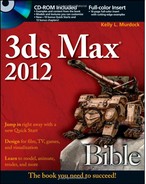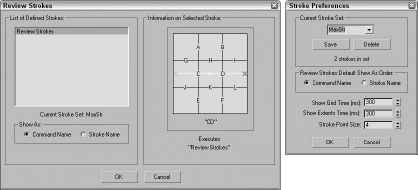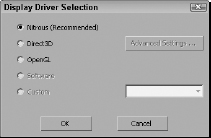CHAPTER 4
Changing Interface Units and Setting Preferences
Setting system units
Learning the general preferences
Altering viewport preferences
Changing gamma preferences
One of the first things you'll want to set before beginning a project is the scene units. Units can be as small as millimeters or as large as kilometers, or they could be generic, which means they have meaning only relative to the other parts of the scene. Max offers a large array of available units, or you can even define your own.
Max also has a rather bulky set of preferences that you can use to set almost every aspect of the program. This chapter also covers various ways to make the Max interface more comfortable for you.
Selecting System Units
One of the first tasks you need to complete before you can begin modeling is to set the system units. The system units have a direct impact on modeling and define the units that are represented by the coordinate values. Units directly relate to parameters entered with the keyboard. For example, with the units set to meters, a sphere created with the radius parameter of 2 would be 4 meters across.
Max supports several different measurement systems, including Metric and U.S. Standard units. You also can define a Custom units system. (I suggest parsecs if you're working on a space scene.) Working with a units system enables you to work with precision and accuracy using realistic values.
Tip
Most game engines work with meters, so if you're building assets for a game, set the units to meters.
To specify a units system, choose Customize ![]() Units Setup to display the Units Setup dialog box, shown in Figure 4.1. For the Metric system, options include Millimeters, Centimeters, Meters, and Kilometers. The U.S. Standard units system can be set to the default units of Feet or Inches displayed as decimals or fractional units. You also can select to display feet with fractional inches or feet with decimal inches. Fractional values can be divided from
Units Setup to display the Units Setup dialog box, shown in Figure 4.1. For the Metric system, options include Millimeters, Centimeters, Meters, and Kilometers. The U.S. Standard units system can be set to the default units of Feet or Inches displayed as decimals or fractional units. You also can select to display feet with fractional inches or feet with decimal inches. Fractional values can be divided from ![]() to
to ![]() increments.
increments.
FIGURE 4.1 The Units Setup dialog box lets you choose which units system to use. Options include Metric, U.S. Standard, Custom, and Generic.
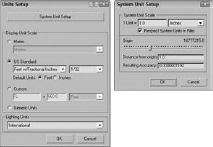
Using Custom and Generic units
To define a Custom units system, modify the fields under the Custom option, including a units label and its equivalence to known units. The final option is to use the default Generic units. Generic units relate distances to each other, but the numbers themselves are irrelevant. You also can set lighting units to use American or International standards. Lighting units are used to define Photometric lights.
At the top of the Units Setup dialog box is the System Unit Setup button. This button opens the System Unit Scale dialog box, also shown in Figure 4.1. This dialog box enables you to define the measurement system used by Max. Options include Inches, Feet, Miles, Millimeters, Centimeters, Meters, and Kilometers.
For example, when using Max to create models that are to be used in the Unreal game editor, you can use the Custom option to define a unit called the Unreal Foot unit that sets 1 Uft equal to 16 units, which matches the units in the Unreal editor just fine.
A multiplier field allows you to alter the value of each unit. The Respect System Units in Files toggle presents a dialog box whenever a file with a different system units setting is encountered. If this option is disabled, all new objects are automatically converted to the current units system.
The Origin control helps you determine the accuracy of an object as it is moved away from the scene origin. If you know how far objects will be located from the origin, then entering that value tells you the Resulting Accuracy. You can use this feature to determine the accuracy of your parameters. Objects farther from the origin have a lower accuracy.
Caution
Be cautious when working with objects that are positioned a long way from the scene origin. The farther an object is from the origin, the lower its accuracy and the less precisely you can move it. If you are having trouble precisely positioning an object (in particular, an object that has been imported from an external file), check the object's distance from the origin. Moving it closer to the origin should help resolve the problem.
Handling mismatched units
Imagine designing a new ski resort layout. For such a project, you'd want to probably use kilometers as the file units. If your next project is to design a custom body design on a race car, then you'll want to use meters as the new units. If you need to reopen the ski resort project while your units are set to meters, then you'll get a File Load: Units Mismatch dialog box, shown in Figure 4.2.
This dialog box reminds you that the units specified in the file that you are opening don't match the current units setting. This also can happen when trying to merge in an object with a different units setting. The dialog box lists the units used in both the file and the system and offers two options. The Rescale the File Objects to the System Unit Scale option changes the units in the file to match the current system units setting. The second option changes the system units to match the file unit settings.
Tip
If you rescale the file object to match the system file units setting, then the objects will either appear tiny or huge in the current scene. Use the Zoom Extents All button to see the rescaled objects in the viewport.
FIGURE 4.2 The Units Mismatch dialog box lets you synch up units between the current file and the system settings.

Rescaling world units
If you discover halfway through your scene that you're working with the wrong units, you can use the Rescale World Units utility to scale up the entire scene or just selected objects. To access this utility, click the Utilities panel and then the More button. In the utilities list, select the Rescale World Units utility and click OK.
The Rescale World Units dialog box has a Scale Factor value, which is the value by which the scene or objects are increased or decreased. If your world was created using millimeter units and you need to work in meters, then increasing by a Scale Factor of 1000 will set the world right.
Setting Preferences
The Preference Settings dialog box lets you configure Max so it works in a way that is most comfortable for you. You open it by choosing Customize ![]() Preferences. The dialog box includes several panels: General, Files, Viewports, Gamma and LUT, Rendering, Radiosity, Animation, Inverse Kinematics, Gizmos, MAXScript, mental ray, Containers, and Help.
Preferences. The dialog box includes several panels: General, Files, Viewports, Gamma and LUT, Rendering, Radiosity, Animation, Inverse Kinematics, Gizmos, MAXScript, mental ray, Containers, and Help.
Tip
The quickest way I've found to open the Preference Settings dialog box is to right-click the Spinner Snap Toggle button on the main toolbar.
General preferences
The first panel in the Preference Settings dialog box is for General settings, as shown in Figure 4.3. The General panel includes many global settings that affect the entire interface.
FIGURE 4.3 The General panel lets you change many UI settings.
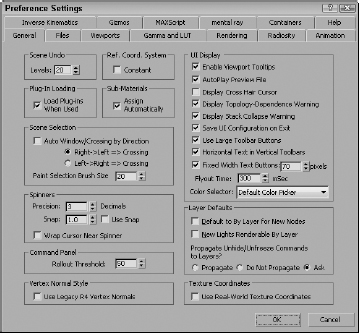
Undo Levels and the Reference Coordinate System
The Scene Undo spinner sets the number of commands that can be kept in a buffer for undoing. A smaller number frees up memory, but does not let you backtrack as far through your work. The default Undo Levels is 20.
Tip
Although it takes up some valuable memory, I've found that increasing the number of Undos is very helpful. When working on a model, it takes almost no time to do 20 commands.
The Reference Coordinate System setting makes all transform tools use the same coordinate system and transform center when the Constant option is enabled. If disabled, each transform (move, scale, and rotate) uses the coordinate system last selected.
Loading Plug-Ins and Sub-Material settings
The Load Plug-Ins When Used option keeps plug-ins out of memory until they are accessed. This saves valuable memory and still makes the plug-ins accessible.
The Automatic Sub-Material Assignment option, when checked, enables materials to be dragged and dropped directly onto a subobject selection. This applies the Multi/Sub-Object material to the object with the dropped material corresponding with the subobject selection's Material ID. If you regularly use the Multi/Sub-Object material, enabling this option can be a great timesaver, but if you aren't familiar with the Multi/Sub-Object material, this option can lead to confusion, making it difficult to locate applied materials.
Scene Selection settings
The Auto Window/Crossing by Direction option lets you select scene objects using the windowing method (the entire object must be within the selected windowed area to be selected) and the crossing method (which selects objects if their borders are crossed with the mouse) at the same time, depending on the direction that the mouse is dragged. If you select the first option, then the Crossing method is used when the mouse is dragged from right to left, and the Window method is used when the mouse is dragged from left to right.
Tip
I like to keep the Auto Window/Crossing by Direction option disabled. I use the Crossing selection method and find that I don't always start my selection from the same side.
The Paint Selection Brush Size value sets the default size of the Paint Selection Brush. In the default interface, this size is set to 20. If you find yourself changing the brush size every time you use this tool, then you can alter its default size with this setting.
Spinner, Rollout, and Vertex Normal settings
Spinners are interface controls that enable you to enter values or interactively increase or decrease the value by clicking the arrows on the right. The Preference Settings dialog box includes settings for changing the number of decimals displayed in spinners and the increment or decrement value for clicking an arrow. The Use Spinner Snap option enables the snap mode.
![]() You also can enable the snap mode using the Spinner Snap button on the main toolbar.
You also can enable the snap mode using the Spinner Snap button on the main toolbar.
Tip
Right-click a spinner to automatically set its value to 0 or its lowest threshold.
You also can change the values in the spinner by clicking the spinner and dragging up to increase the value or down to decrease it. The Wrap Cursor Near Spinner option keeps the cursor close to the spinner when you change values by dragging with the mouse, so you can drag the mouse continuously without worrying about hitting the top or bottom of the screen.
The Rollout Threshold value sets how many pixels can be scrolled before the rollup shifts to another column. This is used only if you've made the Command Panel wider or floating.
The Use Legacy R4 Vertex Normals option computes vertex normals based on the Max version 4 instead of the newer method. The newer method is more accurate but may affect smoothing groups. Enable this setting only if you plan on using any models created using Max R4 or earlier.
Interface Display settings
The options in the UI Display section control additional aspects of the interface. The Enable Viewport Tooltips option can toggle tooltips on or off. Tooltips are helpful when you're first learning the Max interface, but they quickly become annoying, and you'll want to turn them off.
The AutoPlay Preview File setting automatically plays Preview Files in the default media player when they are finished rendering. If this option is disabled, you need to play the previews with the Tools ![]() Grab Viewport
Grab Viewport ![]() View Animated Sequence File menu command. The Display Cross Hair Cursor option changes the cursor from the Windows default arrow to a crosshair cursor similar to the one used in AutoCAD.
View Animated Sequence File menu command. The Display Cross Hair Cursor option changes the cursor from the Windows default arrow to a crosshair cursor similar to the one used in AutoCAD.
For some actions, such as non-uniform scaling, Max displays a warning dialog box asking whether you are sure of the action. To disable these warnings, uncheck this option (or you could check the Disable this Warning box in the dialog box). Actions with warnings include topology-dependence and collapsing the Modifier Stack.
The Save UI Configuration on Exit switch automatically saves any interface configuration changes when you exit Max. You can deselect the Use Large Toolbar Buttons option, enabling the use of smaller toolbar buttons and icons, which reclaims valuable screen real estate.
The Horizontal Text in Vertical Toolbars option fixes the problem of text buttons that take up too much space, especially when printed horizontally on a vertical toolbar. You also can specify a width for text buttons. Any text larger than this value is clipped off at the edges of the button.
The Flyout Time spinner adjusts the time the system waits before displaying flyout buttons. The Color Selection drop-down list lets you choose which color selector interface Max uses.
Layer settings
If you select an object and open its Properties dialog box, the Display Properties, Rendering Control, and Motion Blur sections each have a button that can toggle between ByLayer and ByObject. If ByObject is selected, then the options are enabled and you can set them for the object in the Properties dialog box, but if the ByLayer option is selected, then the settings are determined by the setting defined for all objects in the layer in the Layer Manager.
The settings in the Preference Settings dialog box set the ByLayer option as the default for new objects and new lights. You also have an option to propagate all unhide and unfreeze commands to the layer. You can select Propagate, Do Not Propagate, or Ask.
Real-World Texture Coordinates setting
The Use Real-World Texture Coordinates setting causes the Real-World Scale or the Real-World Map Size option in the Coordinates rollout to be enabled. This setting is off by default, but it can be enabled to be the default by using this setting.
Real-World Texture Coordinates is a mapping method explained in more detail in Chapter 17, “Adding Material Details with Maps.”
Files panel preferences
The Files panel holds the controls for backing up, archiving, and logging Max files. You can set files to be backed up, saved incrementally, or compressed when saved.
Cross-Reference
The Files panel is covered in Chapter 3, “Working with Files, Importing, and Exporting.”
Viewport preferences
The viewports are your window into the scene. The Viewports panel, shown in Figure 4.4, contains many options for controlling these viewports.
FIGURE 4.4 The Viewports panel contains several viewport parameter settings.
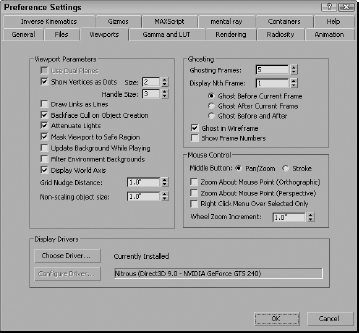
Cross-Reference
Although the viewports are the major topic in Chapter 2, “Controlling and Configuring the Viewports,” the viewport preference settings are covered here.
Viewport parameter options
The Use Dual Planes option enables a method designed to speed up viewport redraws. Objects close to the scene are included in a front plane, and objects farther back are included in a back plane. When this option is enabled, only the objects on the front plane are redrawn.
In subobject mode, the default is to display vertices as small plus signs. The Show Vertices as Dots option displays vertices as either Small or Large dots. The Draw Links as Lines option shows all displayed links as lines that connect the two linked objects.
Caution
I've found that keeping the Draw Links as Lines option turned on can make it confusing to see objects clearly, so I tend to keep it turned off, but it is occasionally useful when trying to determine which objects are linked and to which other object.
When the Backface Cull on Object Creation option is enabled, the backside of an object in wireframe mode is not displayed. If disabled, you can see the wireframe lines that make up the backside of the object. The Backface Cull option setting is determined when the object is created, so some objects in your scene may be backface culled and others may not be. Figure 4.5 includes a sphere and a cube on the left that are backface culled and a sphere and cube on the right that are not.
Note
The Object Properties dialog box also contains a Backface Cull option.
FIGURE 4.5 Backface culling simplifies objects by hiding their backsides.
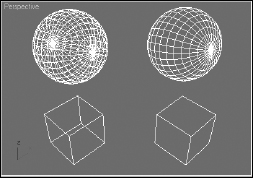
The Attenuate Lights option causes objects farther back in a viewport to appear darker. Attenuation is the property that causes lights to diminish over distance.
In the Viewport Configuration dialog box, you can set Safe Regions, which are borders that the renderer includes. The Mask Viewport to Safe Region option causes the objects beyond the Safe Region border to be invisible.
The Update Background While Playing option causes viewport background bitmaps to be updated while an animation sequence plays. Viewport backgrounds can be filtered if the Filter Environment Background option is enabled, but this slows the update time. If this option is disabled, the background image appears aliased and pixelated.
The Display World Axis option displays the axes in the lower-left corner of each viewport. This can be helpful as you learn to navigate in 3D space. The Grid Nudge Distance is the distance that an object moves when Grid Nudge (+ and - on the numeric keypad) keys are used. Objects without scale, such as lights and cameras, appear in the scene according to the Non-Scaling Object Size value. Making this value large makes lights and camera objects very obvious.
Enabling ghosting
Ghosting is similar to the use of “onion skins” in traditional animation, causing an object's prior position and next position to be displayed. When producing animation, knowing where you're going and where you've come from is helpful.
Max offers several ghosting options. You can set whether a ghost appears before the current frame, after the current frame, or both before and after the current frame. You can set the total number of ghosting frames and how often they should appear. You also can set an option to show the frame numbers.
Cross-Reference
For a more detailed discussion of ghosting, see Chapter 21, “Understanding Animation and Keyframes.”
Using the middle mouse button
If you're using a mouse that includes a middle button (this includes a mouse with a scrolling wheel), then you can define how the middle button is used. The two options are Pan/Zoom and Stroke.
Panning, rotating, and zooming with the middle mouse button
The Pan/Zoom option pans the active viewport if the middle button is held down, zooms in and out by steps if you move the scrolling wheel, rotates the view if you hold down the Alt key while dragging, and zooms smoothly if you drag the middle mouse button with the Ctrl and Alt keys held down. You also can zoom in quickly using the scroll wheel with the Ctrl button held down, or more slowly with the Alt key held down. You can select options to zoom about the mouse point in the Orthographic and Perspective viewports. If disabled, you'll zoom about the center of the viewport. The Right Click Menu Over Selected Only option causes the quadmenus to appear only if you right-click on top of the selected object. This is a bad idea if you use the quadmenus frequently.
Tip
I've found that using the middle mouse button along with the Alt key for rotating is the simplest and easiest way to navigate the viewport, so although Strokes is a clever idea, I always set the middle mouse button to Pan/Zoom.
Using strokes
The Stroke option lets you execute commands by dragging a predefined stroke in a viewport. With the Stroke option selected, close the Preference Settings dialog box and drag with the middle mouse button held down in one of the viewports. A simple dialog box identifies the stroke and executes the command associated with it. If no command is associated, then a simple dialog box appears that lets you Continue (do nothing) or Define the stroke.
Another way to work with strokes is to enable the Strokes Utility. This is done by selecting the Utility panel, clicking the More button, and selecting Strokes from the pop-up list of utilities. This utility makes a Draw Strokes button active. When the button is enabled, it turns yellow and you can draw strokes with the left mouse button and access defined strokes with the middle mouse button.
If you select to define the stroke, the Define Stroke dialog box, shown in Figure 4.6, is opened. You also can open this dialog box directly by holding down the Ctrl key while dragging a stroke with the middle mouse button. In the upper-left corner of this dialog box is a grid. Strokes are identified by the lines they cross on this grid as they are drawn. For example, an “HK” stroke would be a vertical line dragged from the top of the viewport straight down to the bottom.
FIGURE 4.6 The Define Stroke dialog box lets you define specific command strokes that are executed by drawing the stroke with the middle mouse button.
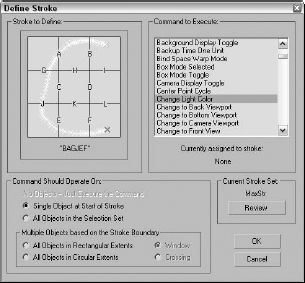
With a stroke identified, you can select a command in the upper-right pane. This is the command that executes when you drag the stroke with the middle mouse button in the viewport. For each command, you can set the options found below the stroke grid. These options define what the command is executed on.
All defined strokes are saved in a set, and you can review the current set of defined strokes with the Review button. Clicking this button opens the Review Strokes dialog box where all defined strokes and their commands are displayed, as shown in Figure 4.7.
One of the commands available in the list of commands is Stroke Preferences. Using this command opens the Stroke Preferences dialog box, also shown in Figure 4.7, where you can save and delete different stroke sets, specify to list commands or strokes in the Review Strokes dialog box, set how long the stroke grid and extents appear, and set the Stroke Point Size.
FIGURE 4.7 The Review Strokes and Stroke Preferences dialog boxes list all defined strokes and their respective commands.
Choosing and configuring display drivers
When Max is installed, it loads the latest custom driver called Nitrous and sets the display to use that driver, but you can change the display driver to Direct3D, OpenGL, or to Software if your video card doesn't support the needed drivers.
New Feature
The new Nitrous display driver allows fast, realistic rendering within the viewport. It also lets you render out non-realistic styles. This display driver and its features are new to 3ds Max 2012.
The Display Drivers section in the Viewports panel of the Preference Settings dialog box lists the currently installed driver. Clicking the Configure Driver button opens a dialog box of settings for the current driver. Clicking the Choose Driver button opens the Display Driver Selection dialog box, shown in Figure 4.8. This dialog box lets you change the display driver to Direct3D, OpenGL, or some custom driver, but unless you have a reason to change it, keep it set to Nitrous or you'll disable some features. If you change the display driver, you need to restart Max.
Caution
The Display Driver Selection dialog box displays the options only for the drivers that it finds on your system, but just because an option exists doesn't mean it works correctly. If a driver hangs your system, you can restart it from a command line with the -h flag after 3dsmax.exe to force Max to present the Graphics Driver Setup dialog box again or use the Start ![]() Programs
Programs ![]() Autodesk
Autodesk ![]() 3ds Max 2012
3ds Max 2012 ![]() Change Graphics Mode program icon to restart the program.
Change Graphics Mode program icon to restart the program.
The Configure Driver option opens a dialog box of configurations for the driver that is currently installed. The various configuration dialog boxes include options such as specifying the Texture Size, which is the size of the bitmap used to texture map an object. Larger maps have better image quality but can slow down your display.
All the display driver configuration settings present tradeoffs between image quality and speed of display. By tweaking the configuration settings, you can optimize these settings to suit your needs. In general, the more memory available on your video card, the better the results.
FIGURE 4.8 You use the Display Driver Selection dialog box to select a different display driver.
On the CD-ROM
You can learn more about the various display drivers in Bonus Chapter 1, “Installing and Configuring 3ds Max 2012,” on the CD.
Gamma preferences
The Gamma and LUT panel, shown in Figure 4.9, controls the gamma correction for the display and for bitmap files. It also includes a Browse button for loading an Autodesk Look-up Table (LUT) file. A Look-up Table is a file that holds all the color calibration settings that can be shared across different types of software and hardware within a studio to maintain consistency.
FIGURE 4.9 Enabling gamma correction makes colors consistent regardless of the monitor.
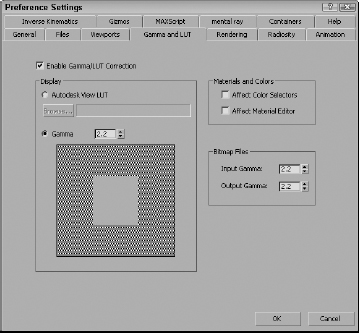
Setting screen gamma
Have you ever noticed in an electronics store that television-screen displays vary in color? Colors on monitor screens may be fairly consistent for related models but may vary across brands. Gamma settings are a means by which colors can be consistently represented regardless of the monitor that is being used.
Gamma value regulates the contrast of an image. It is a numerical offset required by an individual monitor in order to be consistent with a standard. To enable gamma correction for Max, open the Gamma and LUT panel in the Preference Settings dialog box and click the Enable Gamma/LUT Correction option. To determine the gamma value, use the spinner or adjust the Gamma value until the gray square blends in unnoticeably with the background.
Note
3ds Max cannot create LUT files, but it can use existing LUT files created in other software packages, such as Combustion.
Propagating gamma settings
Although gamma settings have a direct impact on the viewports, they do not affect the colors found in the Color Selector or in the Material Editor. Using the Affect Color Selectors and Affect Material Editor options, you can propagate the gamma settings to these other interfaces also.
Setting bitmap gamma
Many bitmap formats, such as TGA, contain their own gamma settings. The Input Gamma setting for Bitmap files sets the gamma for bitmaps that don't have a gamma setting. The Output Gamma setting is the value set for bitmaps being output from Max.
Note
Match the Input Gamma value to the Display Gamma value so that bitmaps loaded for textures are displayed correctly.
Other preference panels
The remaining preference panels, including Rendering, Animation, Inverse Kinematics, Gizmos, MAXScript, Radiosity, mental ray, and Containers, are covered in the related chapters.
Cross-Reference
The details of the Rendering Preferences panel are covered in Chapter 23, “Rendering a Scene and Enabling Quicksilver.” The Animation Preferences panel is covered in Chapter 21, “Understanding Animation and Keyframes.” To learn more about Applied IK and Interactive IK, see Chapter 38, “Understanding Rigging, Kinematics, and Working with Bones.” See Chapter 7, “Transforming Objects, Pivoting, Aligning, and Snapping” for more detail on Gizmo preferences. Check out Bonus Chapter 21, “Automating with MAXScript” for more on MAXScript commands and preferences. Swing over to Chapter 45, “Working with Advanced Lighting, Light Tracing, and Radiosity,” for greater detail on Radiosity preferences. Look to Chapter 47, “Rendering with mental ray and iray,” for more detail on the mental ray renderer. Chapter 9, “Grouping, Linking, and Parenting Objects,” covers the container preferences.
Summary
You can customize the Max interface in many ways. Most of these customization options are included under the Customize menu. In this chapter, you learned how to use this menu and its commands to customize many aspects of the interface. Customizing makes the Max interface more efficient and comfortable for you.
Specifically, this chapter covered the following topics:
- Handling system units
- Setting general preferences
- Changing viewport and gamma preferences
Part II, “Working with Objects,” is next. The first chapter covers the primitive objects and gets some objects into a scene for you to work with.
